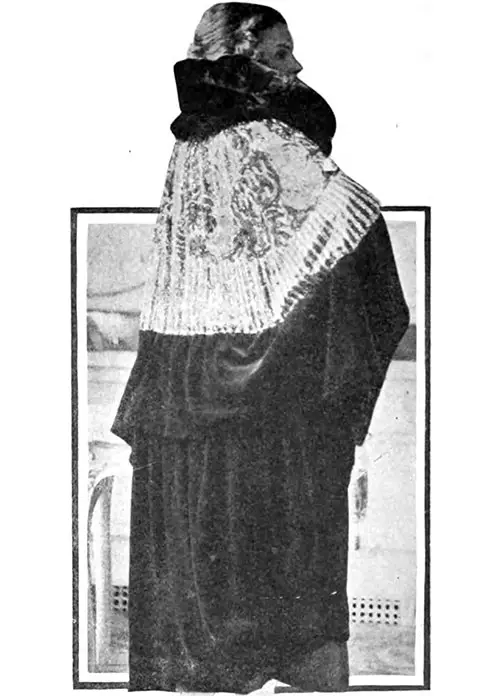Gustav Beer - Parisian Fashion Designer - 1920

Black velvet wrap with deep spangled yoke and big collar of otter.
The collection shown by Beer is one of the successes of the season. It is elegant without eccentricity and never for a moment dull.
The tailor-mades are agreeably varied; we are far from one stereotyped model.
Every kind of jacket is shown, although there is a preference for three-quarter coats and long lines. Skirts, though tight, have a few gathers at the sides shirred into pockets. Collars are divided between all varieties of high necks and an unusual number of the shawl type.
A characteristic suit of beige duvetyn, with a rather long jacket, has a huge shawl collar of seal; the coat fits in at the waist by means of tiny lateral tucks all around. The skirt is box-pleated at the sides.
The leading stuffs are certainly duvetyn, velours de laine, mouflonne, corduroys and serge, in browns and a good many greens, blue-green, turquoise and bottle.
Several plaids and velvet combined with satin complete the list. Long-coated models are either pinched in at the waist and a little skirty or perfectly straight from neck to hem, as in the case of a blue serge, the high collar and huge patch pockets made of narrow red and brown leather strips.
A medium coated tailor-made, baptized “Succès,” more than justified its name. Of fawn duvetyn, the trim, tight coat has a big round collar, vertical strips of mole giving it a fat, tire-like expanse; the sides of the jacket were likewise striped with the same fur opening into big pockets.
Embroidery is not lacking; beautiful silk work weighs down many a panel. One chic blue model, trimmed with squirrel, has a deep yoke, pointed at the back, of silver squares joined by stitching.
All the coats, be they for the evening, afternoon or traveling, deserve description, so different are they from everyone else's. We find much Agnella and velours among the big loose wraps.
The sleeves are particularly huge, a feature being to have them of fur on a wool coat. Beige blanket with immense kolinsky sleeves is chic. Deep yokes and voluminous round collars, rolled and standing out, of fur make a good contrast to the stuff employed.
Another unusual collar is a large, straight piece of beaver, folded over and ruched onto a big green wrap. Squirrel is treated in some mysterious way to look like chinchilla, a valuable secret now fur is so scarce.
The following wrap attracted great attention: of black velvet lined with purple satin, three-quarters of it is shirred at the neck into a straight seal collar; the remainder, or loose flange, is flung over one shoulder like an Italian officer's cloak. The dress underneath, of purple satin, with a red and purple sash, is buttoned all the way down the front.
On evening coats, the yokes are immense. One example has a round one of brocade coming to the hips; a wide, long band of black velvet is draped over it in points, a gathered band of beaver makes the collar. Other equally large yokes are a solid mass of beads and silk in brocade designs.
The more embroidery, the better is the slogan this winter—we meet it everywhere. It is most magnificent, this dead turquoise wrap, much gathered and bunchy, striped in bands of cut steel all the way down.
For dresses, the straight line is, of course, popular. Not too loose, for I do not remember an example of the robe-chemise. The narrow effect is strictly adhered to, in spite of the constant use of panels, loops or aprons, which are put on so flat that they are barely suspected unless the wearer moves about.
Kashavella and velvets are the best materials in black or blue. This is not as somber as it looks, for coat dresses are usually worn over a different lining of a bright hue.
The coat may be worn over a separate front—a green cloth had a detached back over a satin front while a blue serge opens over a brick front embroidered in big, shawl pattern motifs.
One blue serge over black had no trimmings, and needed none, for it was made of a new stuff, serge kashe myrina, the goods woven at intervals with tiny silk braids of a cashmere design. A very chic geranium cloth, buttoned in jet from top to bottom, is box-pleated at the back, quite a refreshing change from plain effects.
All these dresses have tight, long sleeves and uncompromising of high collars. A black velvet with a severe, dignified line is enlivened by gold embroidery on the belt, sleeves, and front.
The “Medieval” line, tight and low waisted, makes another black velvet, with a straight shoulder line, the wide armholes, belt, and neck forming a square outlined in gold braid and turquoises.
Late afternoon and dinner dresses are more ample, with round necks and looser sleeves; black satin and lace are not found lacking. Here, as in every other good house, black runs through the entire collection.
A black satin, with a much-embroidered front of green silk, has a shirred black net tunic worked in rows of green chenille dots; a gorgeous apron of gold and silver lace bordered by sealskin completes a black velvet frock.
"Beer" in the Garment Manufacturers’ Index, New York: The Allen-Nugent Co. Publishers, Vol. II, No. 3, October 1920: 22.
